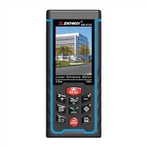Precautions for Infrared Thermometer in Equipment Fault Diagnosis
Influence of Atmospheric Attenuation: The infrared radiation energy on the surface of the electrical equipment under test is transmitted to the infrared detection instrument through the atmosphere, which will be affected by the absorption attenuation of water vapor, carbon dioxide, carbon monoxide and other gas molecules in the atmospheric combination and the scattering attenuation of suspended particles in the air . The attenuation of the radiation energy transmission of the equipment will reduce the radiation transmittance of the equipment under test with the distance between the testing instrument and the equipment under test, so the attenuation increases with the increase of the distance. Reducing the radiation contrast between the faulty part of the tested equipment and the normal part will also reduce the target energy received by the infrared instrument, making the temperature displayed by the instrument lower than the actual temperature value of the faulty point under test, resulting in missed detection or misdiagnosis. Especially for detecting equipment failures with low temperature rise. As the detection distance increases, the influence of atmospheric combination will become greater and greater. In this way, to obtain the accuracy of the target temperature, it is necessary to choose a season when the ambient atmosphere is relatively dry and clean for detection; to shorten the detection distance as much as possible without affecting it, and to make a reasonable distance correction to the temperature measurement results , in order to measure the actual temperature value.
Influence of meteorological conditions: Harsh weather conditions (rain, snow, fog and strong wind, etc.) will have adverse effects on the temperature detection of the equipment, and often give false fault phenomena. In order to reduce the impact of meteorological conditions, try to conduct detection at night when there is no rain, no fog, no wind and the ambient temperature is relatively stable.
Influence of environment and background radiation: When performing infrared detection of outdoor power equipment, the infrared radiation received by the detection instrument includes not only the radiation emitted by the corresponding part of the tested equipment itself, but also the reflection from other parts of the equipment and the background, as well as direct radiation. Sun radiation. These radiations will interfere with the temperature of the part of the device to be tested, and cause errors in fault detection. In order to reduce the impact of the environment and background radiation, when conducting on-site infrared inspections of outdoor electrical equipment, it is best to choose cloudy days or sunsets and evenings when there is no light. This can prevent direct incident, reflected and scattered solar radiation; for indoor equipment, it can be used to turn off the lighting and avoid the influence of other radiation. For highly reflective equipment surfaces, appropriate measures should be taken to reduce the impact on solar radiation and radiation from surrounding high-temperature objects, or change the detection angle to find the best angle that can avoid reflection for detection. In order to reduce the influence of solar radiation and the radiation of the surrounding high temperature background, appropriate shielding measures should be taken during detection, or an appropriate infrared filter should be installed on the infrared measuring instrument to filter out the sun and other background radiation. Select an instrument with appropriate parameters and a detection distance for detection, so that the part of the device under test is within the field of view of the instrument, thereby reducing the interference of background radiation.










